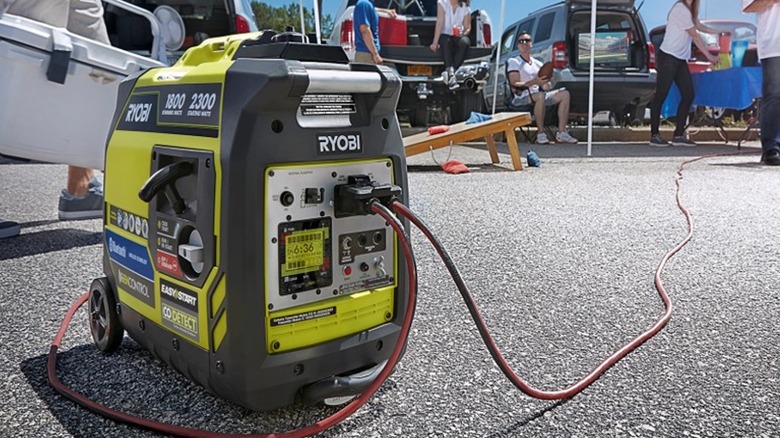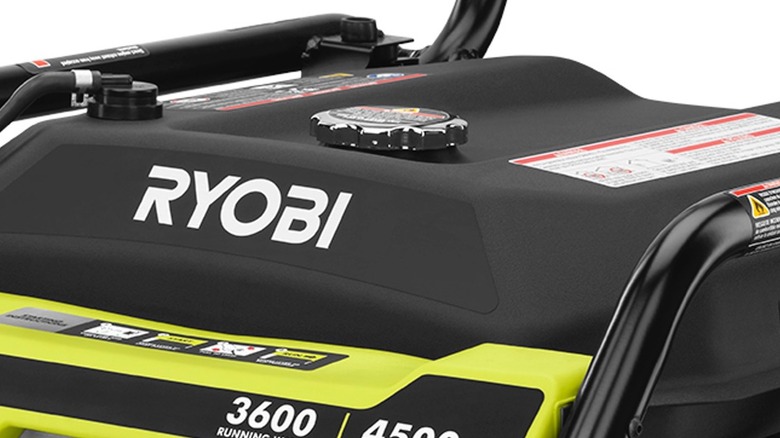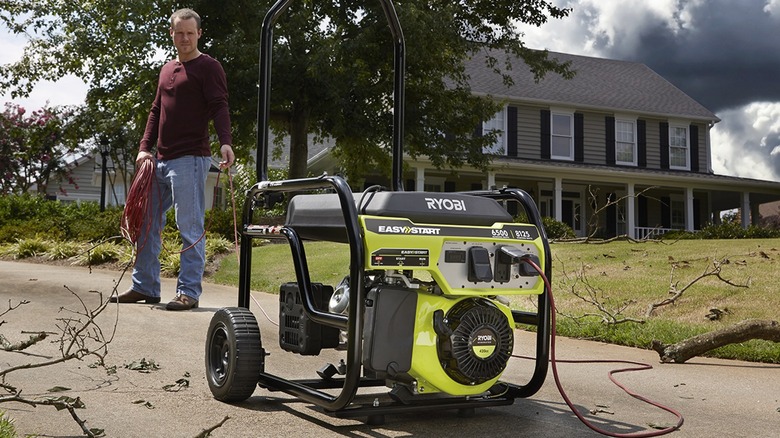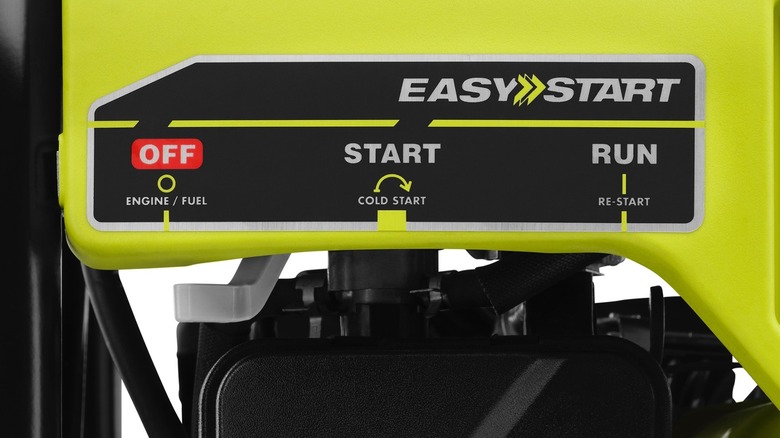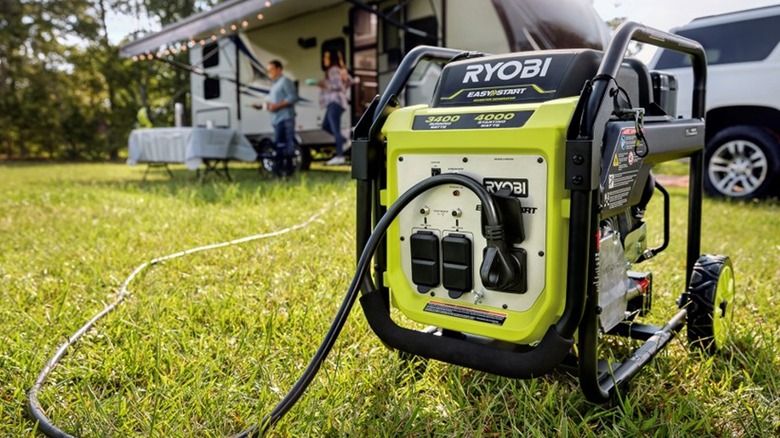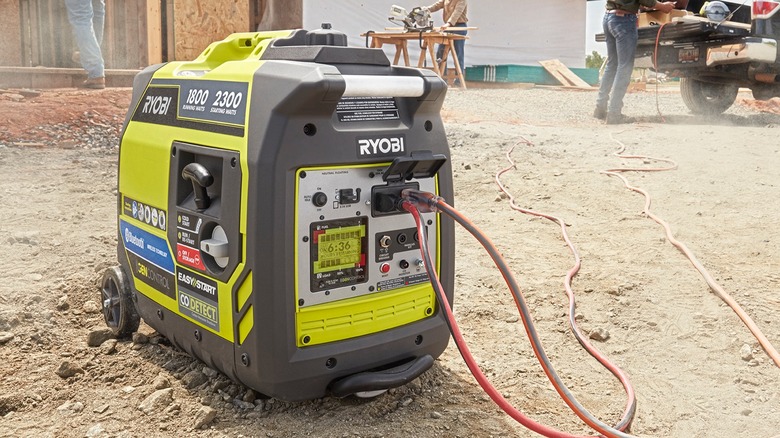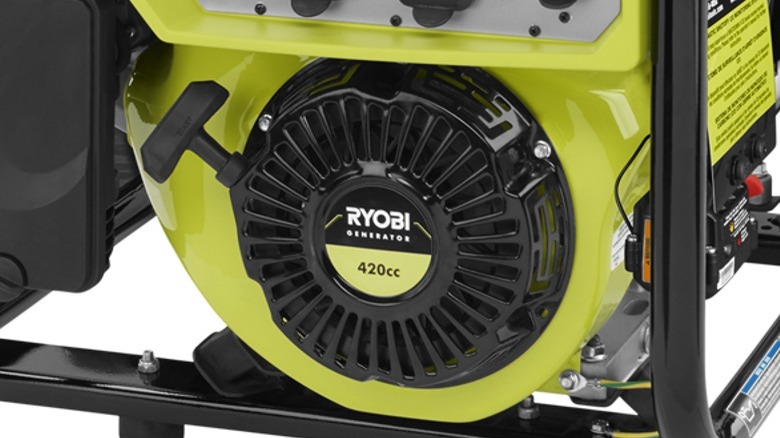6 Common Reasons Why Your Ryobi Generator Won't Start (And Fixes To Try)
We may receive a commission on purchases made from links.
It's never fun to have a generator break down. These energy-producing appliances can be a convenience when camping or doing labor off the grid, but they can also be an absolute necessity during power outages. That's why it's important to know what kinds of things can go wrong with your generator and the best ways to fix them if they do.
Ryobi makes a variety of different generators that suit all kinds of situational needs. The company makes both powerful, high-wattage gas units that are noisier, but typically have a higher energy output, as well as quieter and more fuel-efficient models such as its 4,000W inverter generator. So, you shouldn't have any trouble choosing the right generator for your home during your next Home Depot trip.
Ryobi also has a good reputation for reliability and the company's warranty should cover defective units for up to three years so long as it's used for you and your household and not a business. So, your best bet might be to exchange a faulty generator for a new one if you encounter any serious issues. That said, you rarely need a generator when it's convenient to go out to the store and trade one in. There are times when you might need to troubleshoot the reason why your Ryobi generator isn't working and try a few fixes to see if you can get it going again.
Old gas
One thing that just about every generator has in common is that they all run on gasoline. Gas doesn't last forever though, and old gas can cause all kinds of problems in your machines. Untreated gasoline usually only lasts about 3-6 months. After that, it starts to break down. "Old gas does not become contaminated necessarily, but rather loses its combustible properties and volatile compounds," says Risolene. "When you use gasoline that's too old, it can damage internal engine components. It may also start to form a gum residue that could cause blockages. If there's ethanol in the fuel, it may draw water vapor into your fuel line, which could result in internal corrosion."
If all of the electronic and mechanical components in your generator are working properly but the motor is simply failing to start, then there is a strong possibility that the gas is too old to properly combust. Luckily, fixing this may be as simple as draining the gas that is currently in your generator and replacing it with new fresh gas. Additives like STP Gas Treatment can also help extend the life of your gasoline by removing water and halting the accumulation of harmful deposits like carbon, gum, and varnish. These can also help clean out a generator that has had old gas sitting in it for a long time.
The lubricant level is low
Just like all engines, generators require lubricant in order to run properly. This probably seems like a no-brainer, but most engines would still start, even if they didn't have enough oil–in spite of the fact that this could end in the engine seizing entirely. You might not have realized, though, that several Ryobi Generators, such as the Ryobi Inverter 2,300 Bluetooth, actually have a built-in Low Oil Shutoff feature. This is a safety mechanism that protects the generator from damage by preventing it from starting if its sensors don't detect enough lubricant in its system.
Remedying this is easy. Simply check the oil level in your generator. If it is low, consult your manual for the kind of oil that it takes as well as the amount that it should have. This may also be a good opportunity to drain any old or dirty oil and replace it with fresh lubricant. Make sure you fill the reservoir to the appropriate level. The generator should immediately resume functioning like normal once there is a sufficient amount of oil.
Bad spark plug
Just like all gas engines, Ryobi generators need spark plugs in order to start. These little gizmos are essential in order to produce the initial ignition of the air-fuel mixture inside the combustion chamber. Spark plugs are fairly fragile, however, and there are a lot of things that can prevent them from being able to adequately do their job. Heavy carbon buildup at the electrode can prevent the electrode from adequately making contact, The electrode itself can be damaged, many of them have porcelain insulators that can easily be cracked.
Sadly, the only thing that you will be able to do if the plug itself is damaged is get a replacement. You might be able to tell if this is the case simply by removing and inspecting the plug. Visible damage to the casing or the electrode is a pretty good hint that the plug probably isn't functioning the way it's supposed to, but there are also spark plug testers that you can use to verify whether the part is working or not. Ryobi sells first party 2-cycle and 4-cycle spark plugs that are made specifically for its generators. It might be good to keep one or two of these in reserve in case of emergency.
You might have a few other options if the plug simply has a carbon build-up though. You can try using sandpaper, a file, or a wire brush to gently remove the carbon from the electrode. You can also use a penetrating oil to loosen the carbon if there is a heavy amount of build-up.
Faulty ignition coil
If the spark plug is working fine and you're still having trouble achieving ignition, then it may be that you have a defective ignition coil. This is the connective device that is responsible for sending voltage to the spark plug. It's usually a pretty big hint that the ignition coil is the problem when you test or replace a spark plug and find that it's still not producing a spark. You can also use an ignition coil tester to determine if the component is functioning properly.
Unfortunately, there isn't much you can do to fix a faulty ignition coil. You can try to exchange it if your generator is still under warranty. If not, you'll probably have to replace it. Fortunately, Home Depot has an ordering service that allows you to look up the exact part you need simply by entering your model number. You should be able to use this to find and order the ignition coil.
Replacing it is an easy-to-moderate-difficulty task that may require simple tools like a ratchet set and a few screwdrivers. You may need to remove an engine shroud, but the ignition coil should be located outside the engine casing. You will then have to disconnect it from the panel and spark plugs, remove any fasteners, and replace it with the new unit.
Dirty or damaged carburetor
A lot of the newer Ryobi Generators now use injection systems to create the fuel-air mixture inside their engine, but many of the older and cheaper models use carburetors. There are some pros and cons to this method. Carburetors are generally cheaper to manufacture but often require significantly more maintenance. This is because the aeration chambers can get gummed up with all those same carbon, gum, and varnish fuel deposits we talked about earlier. Problems in this area are usually first indicated by the generator struggling to start, starting weakly, or sputtering out, but they can eventually result in the generator not starting at all as the combustion chamber receives an insufficient supply of fuel.
There are a few things you can do to fix this. There are fuel additives that you can add to try and break down some of the gunk in the carburetor as it runs, but these are rarely as good as a thorough cleaning. Carburetor cleaner is available in several hardware and auto repair stores. Taking it apart to clean it can be a bit of a headache, and the cleaner is hazardously corrosive, but it's a necessary step to get your generator up and running if it isn't combusting properly.
In the worst-case scenario, the carburetor may be damaged and you may need to replace it. If that's the case, you can once again use the same Home Depot ordering service to find the right carburetor for your model.
Faulty recoil starter assembly
A lot of the newer Ryobi generators have electronic starters (which can have issues of their own) but many of them still use a recoil starter assembly. This is the ripcord that you pull when you start the motor. It works by engaging the generator's crankshaft when you pull on the cord, forcibly turning over the engine. Once you've checked the gas, the ignition system, and the carburetor, this is the next thing on the list to check.
Doing so is a bit of a hassle though. You need to remove the starter assembly and inspect it to make sure that it is fully intact and working properly. Pulling the cord should make tabs that extend from the pulley and the cam initiate a turning motion in the engine hub. Then releasing it should force a spring to reverse the course coil's course and spin in the engine in the opposite direction while the cord retracts. Both the spring and these tabs can break, however, which means that pulling the cord isn't rotating the engine. If this isn't working properly, then your best option is to purchase a new recoil starter. You can try to find a complete assembly from a third-party site like Amazon or you can order more obscure parts like this directly from Ryobi's OEM replacement parts and accessories catalog. Simply search for your generator's model number and then look for the recoil starter assembly.
